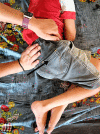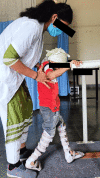Effectiveness of a Blend of Pelvic Proprioceptive Neuromuscular Facilitation, Task-Oriented Approach, and Rood's Approach in a Three-Year-Old Child With Spastic Diplegia: A Case Report
- PMID: 36475170
- PMCID: PMC9719398
- DOI: 10.7759/cureus.31063
Effectiveness of a Blend of Pelvic Proprioceptive Neuromuscular Facilitation, Task-Oriented Approach, and Rood's Approach in a Three-Year-Old Child With Spastic Diplegia: A Case Report
Abstract
As a result of non-progressive brain damage, cerebral palsy (CP) has traditionally been seen as a disorder of movement and posture; however, more recent classifications enable clinicians to understand more than just the movement issue. Research has evolved with the accurate categorization of cerebral palsy into distribution, motor type, and functional level. Children with spastic diplegia usually have pelvic asymmetry, which affects the child's functional abilities, including their ability to balance and walk independently. Physical therapists currently treat this illness using a variety of treatments, each of which is significant in its own way. A model for enhancing organizational capabilities is clinical management in physical therapy, which incorporates effective practices supported by research and improves outcomes. This case study demonstrates the efficiency of a deliberate physical therapy strategy to enhance functional independence in a three-year-old male child with spastic diplegia. The young patient complained of difficulties with balance and toe-walking and a delay in reaching age-appropriate milestones when seen in the neuro physiotherapy outpatient department. History demonstrated that a delayed cry occurred with an abrupt onset of fever, foaming at the mouth, and other symptoms described.
Keywords: cerebral palsy; proprioception neuromuscular facilitation; rood’s approach; spastic diplegia; task-oriented approach.
Copyright © 2022, Pachkhede et al.
Conflict of interest statement
The authors have declared that no competing interests exist.
Figures
Similar articles
-
Multiple Approaches of Neuro-Physiotherapy Used for Improving Balance, Normalizing Tone, and Gait Training in a Child With Ataxic Cerebral Palsy: A Case Report.Cureus. 2023 Dec 10;15(12):e50264. doi: 10.7759/cureus.50264. eCollection 2023 Dec. Cureus. 2023. PMID: 38196428 Free PMC article.
-
Appraisal of the Effectiveness of Pelvic Proprioceptive Neuromuscular Facilitation Methods to Optimize Balance and Gait in an Eight-Year-Old Child.Cureus. 2022 Sep 27;14(9):e29648. doi: 10.7759/cureus.29648. eCollection 2022 Sep. Cureus. 2022. PMID: 36320954 Free PMC article.
-
Effectiveness of Pelvic Proprioceptive Neuromuscular Facilitation on Balance and Gait Parameters in Children With Spastic Diplegia.Cureus. 2022 Oct 22;14(10):e30571. doi: 10.7759/cureus.30571. eCollection 2022 Oct. Cureus. 2022. PMID: 36415346 Free PMC article.
-
Cerebral palsy in children: a clinical overview.Transl Pediatr. 2020 Feb;9(Suppl 1):S125-S135. doi: 10.21037/tp.2020.01.01. Transl Pediatr. 2020. PMID: 32206590 Free PMC article. Review.
-
Physical therapy clinical management recommendations for children with cerebral palsy - spastic diplegia: achieving functional mobility outcomes.Pediatr Phys Ther. 2006 Spring;18(1):49-72. doi: 10.1097/01.pep.0000202099.01653.a9. Pediatr Phys Ther. 2006. PMID: 16508534 Review.
Cited by
-
Multiple Approaches of Neuro-Physiotherapy Used for Improving Balance, Normalizing Tone, and Gait Training in a Child With Ataxic Cerebral Palsy: A Case Report.Cureus. 2023 Dec 10;15(12):e50264. doi: 10.7759/cureus.50264. eCollection 2023 Dec. Cureus. 2023. PMID: 38196428 Free PMC article.
References
-
- The epidemiology of cerebral palsy: incidence, impairments and risk factors. Odding E, Roebroeck ME, Stam HJ. Disabil Rehabil. 2006;28:183–191. - PubMed
-
- Cerebral palsy. Wimalasundera N, Stevenson VL. https://pn.bmj.com/content/16/3/184. Pract Neurol. 2016;16:184–194. - PubMed
-
- Quantitative clinical measure of spasticity in children with cerebral palsy. Engsberg JR, Olree KS, Ross SA, Park TS. Arch Phys Med Rehabil. 1996;77:594–599. - PubMed
Publication types
LinkOut - more resources
Full Text Sources
Research Materials
Miscellaneous




